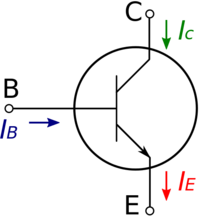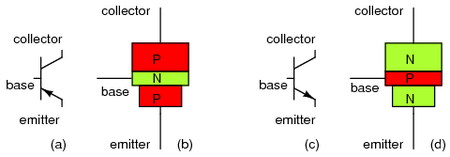Transistor

Transistors are components of electric circuits that can act as amplifiers and as switches. Transistors are integral to modern circuitry, with hundreds of millions of them used in modern integrated circuits for computing. They are the basis for digital logic and computation, and they catalyzed a revolution in electronics.[2] The most basic type of transistor is the bipolar junction transistor (see Figure 1).
Types and Functions
Bipolar junction transistors (BJT) are composed of three doped semiconductors. NPN transistors have a thin p-doped region between two n-doped sections while PNP transistors have a thin n-doped region between two p-doped sections. The only functional difference between PNP and NPN transistors is the biasing of each PN diode required for the transistor to work.[3] All three regions of the transistor have a distinct connection to the external circuit (see Figure 2). The end regions are called the collector and emitter such that conventional current flow is from collector to emitter through an NPN transistor.[4]

Bipolar transistors work as current regulators or electronic switches. Depending on the voltage of the small current through the base, the much larger collector-to-emitter current can be strictly controlled or shut off.
Most modern transistors are known as Metal Oxide Semiconductor Field Effect Transistors (MOSFETs), which work on the same principles as BJTs but are constructed and operated quite differently. However, both BJTs and MOSFETs have the same fundamental capability of controlling a large current with a small one.[5]
For more information on how transistors work, visit All About Circuits and the simulation at Learn About Electronics.
Uses
Transistors are ubiquitous in modern electronics, but the most fundamental use of a transistor is as an electronic switch. In cutoff mode, a transistor will allow no current to pass between the collector and emitter. In saturation mode, the transistor allows unrestricted current flow. These two distinct states create a binary effect that can be exploited to create logic gates, microcontrollers, microprocessors, and other integrated circuits.[6] As such, the transistor is the fundamental component of all digital computing.
Transistors are also widely used as amplifiers, since they take a small input current through the base to produce a larger, proportional current between the collector and emitter. Amplification plays a key role in many circuits, most obviously in microphones, loudspeakers, radios, televisions, phones, and hearing aids.[7][8] Transistor amplification also allows for large current gains and complex processes like differential amplification, where the difference between two input signals is amplified.[7]
For Further Reading
For further information please see the related pages below:
- Semiconductor
- Metal
- Photovoltaic cell
- AC to DC adapter
- Or explore a random page!
References
- ↑ Wikimedia Commons. File:Diagrama de Transistor NPN.svg [Online]. Available: https://commons.wikimedia.org/wiki/File:Diagrama_de_Transistor_NPN.svg
- ↑ How Transistors Work - Transistors and the Computer Age [Online]. Available: http://electronics.howstuffworks.com/transistor3.htm
- ↑ 3.0 3.1 Introduction to Bipolar Junction Transistors (BJT) [Online]. Available:http://www.allaboutcircuits.com/textbook/semiconductors/chpt-4/bipolar-junction-transistors-bjt/
- ↑ Transistors [Online]. Available:https://learn.sparkfun.com/tutorials/transistors/operation-modes
- ↑ Junction Field Effect Transistor [Online]. Available: http://hyperphysics.phy-astr.gsu.edu/hbase/electronic/fet.html
- ↑ Transistors - Applications I: Switches [Online]. Available: https://learn.sparkfun.com/tutorials/transistors/applications-i-switches
- ↑ 7.0 7.1 Transistors - Applications II: Amplifiers [Online]. Available: https://learn.sparkfun.com/tutorials/transistors/applications-ii-amplifiers
- ↑ How Transistors Work - Transistor Radios and the Electronics Revolution [Online]. Available: http://electronics.howstuffworks.com/transistor2.htm

